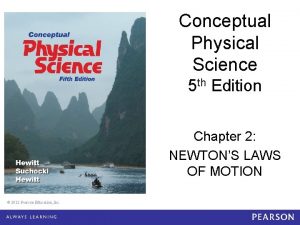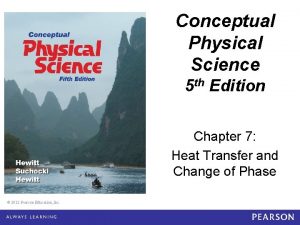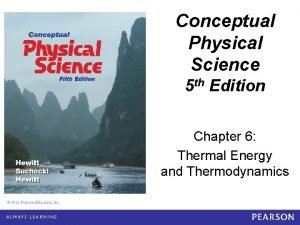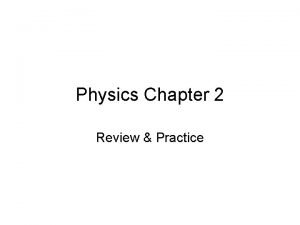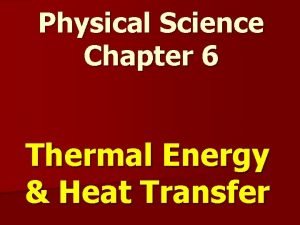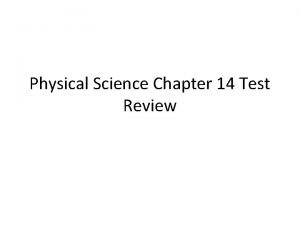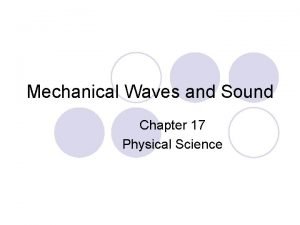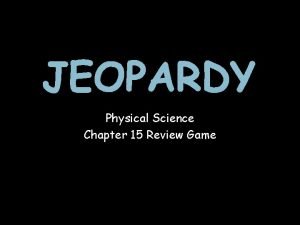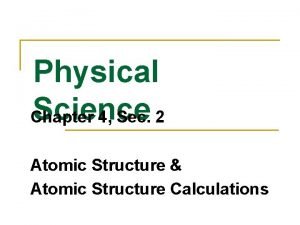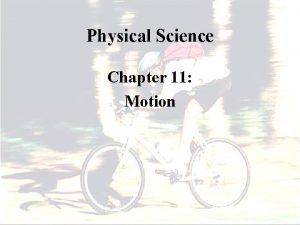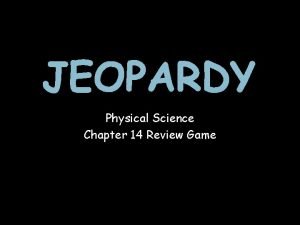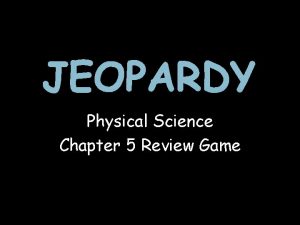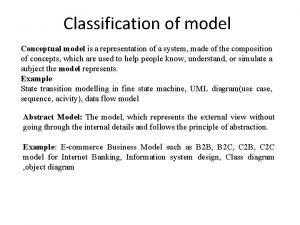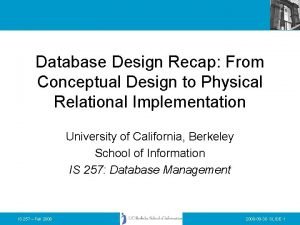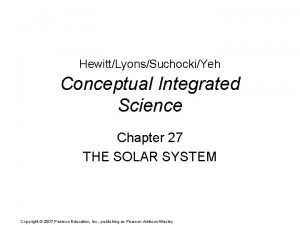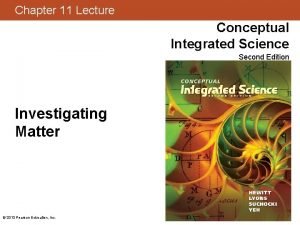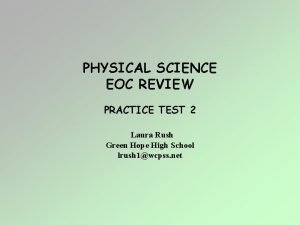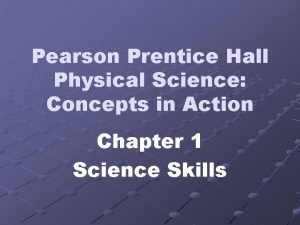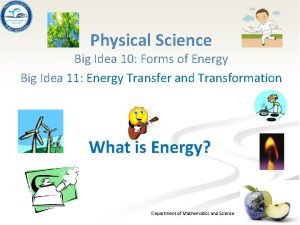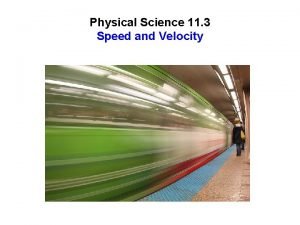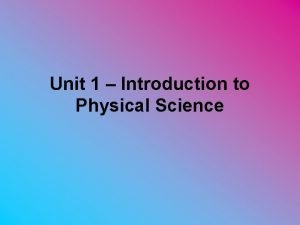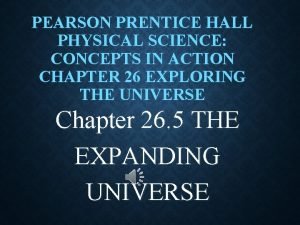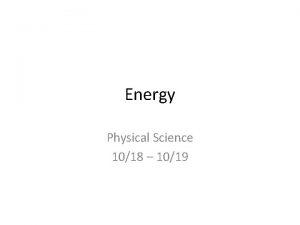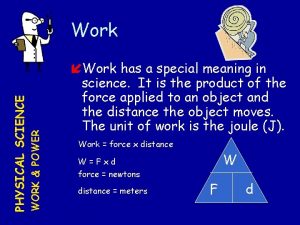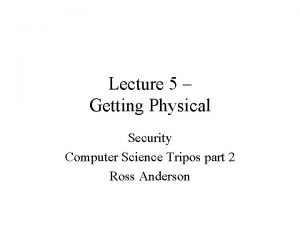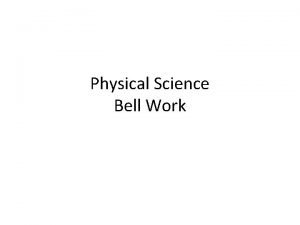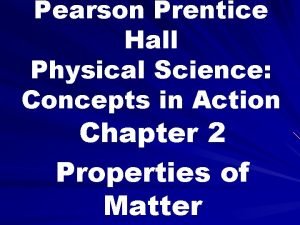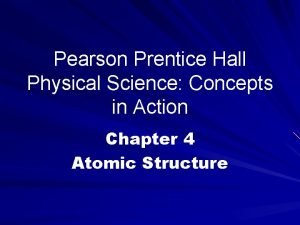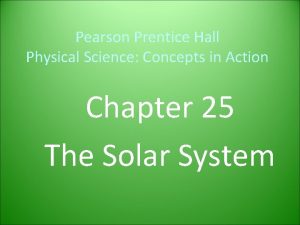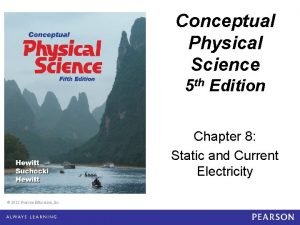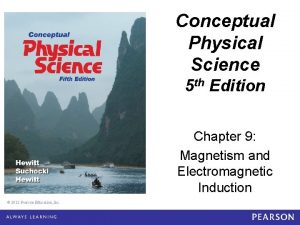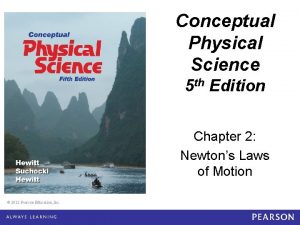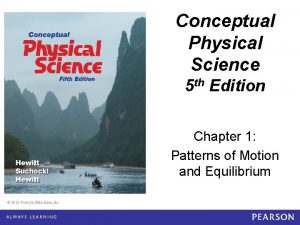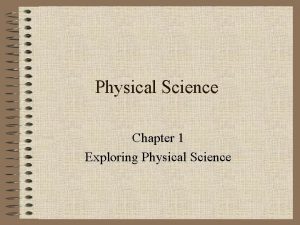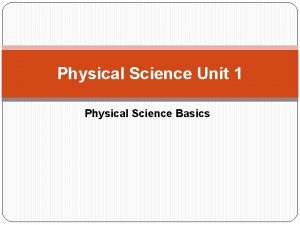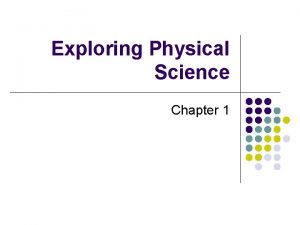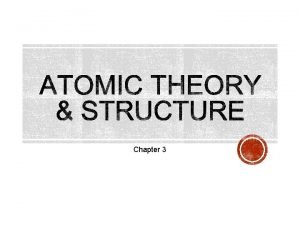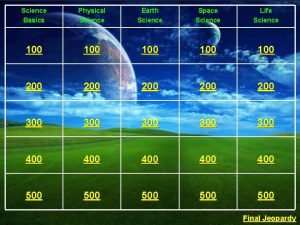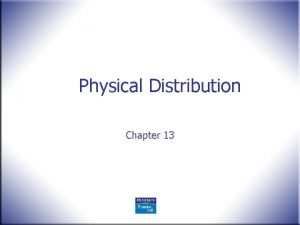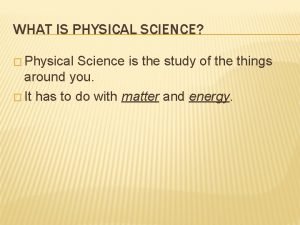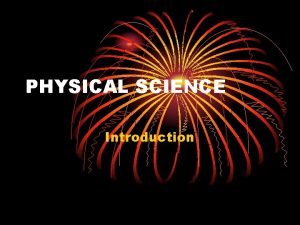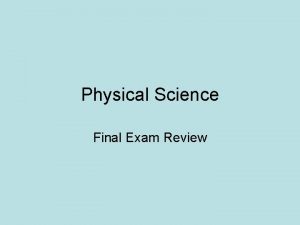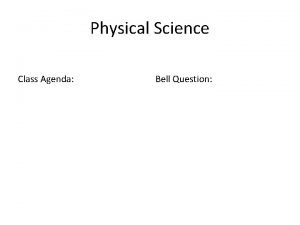Conceptual Physical Science 5 e Chapter 10 Conceptual





























































- Slides: 61

Conceptual Physical Science 5 e — Chapter 10 Conceptual Physical Science 5 th Edition Chapter 10: Waves and Sound © 2012 Pearson Education, Inc.

Conceptual Physical Science 5 e — Chapter 10 A wiggle in time is a A. B. C. D. vibration. wave. both of these. neither of these. © 2012 Pearson Education, Inc.

Conceptual Physical Science 5 e — Chapter 10 A wiggle in time is a A. B. C. D. vibration. wave. both of these. neither of these. Comment: And a wiggle in time that transports energy from one place to another is a wave. © 2012 Pearson Education, Inc.

Conceptual Physical Science 5 e — Chapter 10 When we consider how frequently a pendulum swings to and fro, we’re talking about its A. B. C. D. frequency. period. wavelength. amplitude. © 2012 Pearson Education, Inc.

Conceptual Physical Science 5 e — Chapter 10 When we consider how frequently a pendulum swings to and fro, we’re talking about its A. B. C. D. frequency. period. wavelength. amplitude. Comment: And when we talk about the time that occurs for one complete vibration, we’re talking about its period. © 2012 Pearson Education, Inc.

Conceptual Physical Science 5 e — Chapter 10 The speed of sound in air at room temperature is about A. B. C. D. 300, 000 m/s. 340 m/s. 1000 m/s. © 2012 Pearson Education, Inc.

Conceptual Physical Science 5 e — Chapter 10 The speed of sound in air at room temperature is about A. B. C. D. 300, 000 m/s. 340 m/s. 1000 m/s. © 2012 Pearson Education, Inc.

Conceptual Physical Science 5 e — Chapter 10 The frequency of a wave is the inverse of its A. B. C. D. frequency. period. wavelength. amplitude. © 2012 Pearson Education, Inc.

Conceptual Physical Science 5 e — Chapter 10 The frequency of a wave is the inverse of its A. B. C. D. frequency. period. wavelength. amplitude. Explanation: Note the inverse relationship: = 1/T, T = 1/. So, we can also say the period of a wave is the inverse of its frequency. © 2012 Pearson Education, Inc.

Conceptual Physical Science 5 e — Chapter 10 The distance between adjacent peaks in the direction of travel for a transverse wave is its A. B. C. D. frequency. period. wavelength. amplitude. © 2012 Pearson Education, Inc.

Conceptual Physical Science 5 e — Chapter 10 The distance between adjacent peaks in the direction of travel for a transverse wave is its A. B. C. D. frequency. period. wavelength. amplitude. Explanation: The wavelength of a transverse wave is also the distance between adjacent troughs, or between any adjacent identical parts of the waveform. © 2012 Pearson Education, Inc.

Conceptual Physical Science 5 e — Chapter 10 In Europe, an electric razor completes 50 vibrations within 1 second. The frequency of these vibrations is A. B. C. D. 50 Hz with a period of 1/50 second. 1/ 50 Hz with a period of 50 seconds. 1/ 1 50 Hz with a period of /50 second. © 2012 Pearson Education, Inc.

Conceptual Physical Science 5 e — Chapter 10 In Europe, an electric razor completes 50 vibrations within 1 second. The frequency of these vibrations is A. B. C. D. 50 Hz with a period of 1/50 second. 1/ 50 Hz with a period of 50 seconds. 1/ 1 50 Hz with a period of /50 second. Explanation: Note when = 50 Hz, T = 1/(50 Hz) = 1/50 second. © 2012 Pearson Education, Inc.

Conceptual Physical Science 5 e — Chapter 10 Compared with the speed of a sound wave, a radio wave travels A. B. C. D. most often, faster always in all conditions. about the same speed as a sound wave in the same temperature air. slower under some conditions. © 2012 Pearson Education, Inc.

Conceptual Physical Science 5 e — Chapter 10 Compared with the speed of a sound wave, a radio wave travels A. B. C. D. most often, faster always in all conditions. about the same speed as a sound wave in the same temperature air. slower under some conditions. Explanation: A radio wave is electromagnetic, and travels at the speed of light! © 2012 Pearson Education, Inc.

Conceptual Physical Science 5 e — Chapter 10 If you dip your finger repeatedly onto the surface of still water, you produce waves. The more frequently you dip your finger, the A. B. C. D. lower the wave frequency and the longer the wavelengths. higher the wave frequency and the shorter the wavelengths. Strangely, both of the above. Neither of the above. © 2012 Pearson Education, Inc.

Conceptual Physical Science 5 e — Chapter 10 If you dip your finger repeatedly onto the surface of still water, you produce waves. The more frequently you dip your finger, the A. B. C. D. lower the wave frequency and the longer the wavelengths. higher the wave frequency and the shorter the wavelengths. Strangely, both of the above. Neither of the above. © 2012 Pearson Education, Inc.

Conceptual Physical Science 5 e — Chapter 10 The vibrations along a longitudinal wave move in a direction A. B. C. D. along the wave. perpendicular to the wave. Both of the above. Neither of the above. © 2012 Pearson Education, Inc.

Conceptual Physical Science 5 e — Chapter 10 The vibrations along a longitudinal wave move in a direction A. B. C. D. along the wave. perpendicular to the wave. Both of the above. Neither of the above. Comment: And the vibrations along a transverse wave are at right angles to the direction of wave travel. © 2012 Pearson Education, Inc.

Conceptual Physical Science 5 e — Chapter 10 A common example of a longitudinal wave is A. B. C. D. sound. light. Both of the above. None of the above. © 2012 Pearson Education, Inc.

Conceptual Physical Science 5 e — Chapter 10 A common example of a longitudinal wave is A. B. C. D. sound. light. Both of the above. None of the above. Comment: And a common example of a transverse wave is light. © 2012 Pearson Education, Inc.

Conceptual Physical Science 5 e — Chapter 10 The kind of wave produced by a vibrating source is A. B. C. D. sound. light. Both of the above. Neither of the above. © 2012 Pearson Education, Inc.

Conceptual Physical Science 5 e — Chapter 10 The kind of wave produced by a vibrating source is A. B. C. D. sound. light. Both of the above. Neither of the above. Comment: The source of all waves is a vibrating source. © 2012 Pearson Education, Inc.

Conceptual Physical Science 5 e — Chapter 10 The kind of wave whose speed is given by the equation speed = frequency wavelength is A. B. C. D. sound. light. Both of the above. None of the above. © 2012 Pearson Education, Inc.

Conceptual Physical Science 5 e — Chapter 10 The kind of wave whose speed is given by the equation speed = frequency wavelength is A. B. C. D. sound. light. Both of the above. None of the above. © 2012 Pearson Education, Inc.

Conceptual Physical Science 5 e — Chapter 10 The reflection of a sound wave is known as its A. B. C. D. pitch. harmony. echo. virtual image. © 2012 Pearson Education, Inc.

Conceptual Physical Science 5 e — Chapter 10 The reflection of a sound wave is known as its A. B. C. D. pitch. harmony. echo. virtual image. © 2012 Pearson Education, Inc.

Conceptual Physical Science 5 e — Chapter 10 Low-pitched sounds have A. B. C. D. low frequencies. long periods. Both of the above. None of the above. © 2012 Pearson Education, Inc.

Conceptual Physical Science 5 e — Chapter 10 Low-pitched sounds have A. B. C. D. low frequencies. long periods. Both of the above. None of the above. Explanation: A low frequency has a long period. If you missed this, be careful in answering too quickly. © 2012 Pearson Education, Inc.

Conceptual Physical Science 5 e — Chapter 10 The speed of sound varies with A. B. C. D. amplitude. frequency. temperature. All of the above. © 2012 Pearson Education, Inc.

Conceptual Physical Science 5 e — Chapter 10 The speed of sound varies with A. B. C. D. amplitude. frequency. temperature. All of the above. Explanation: Although loudness varies with amplitude, and pitch varies with frequency, speed is not influenced by amplitude and frequency. If it were, sitting in the back row at a concert would be quite confusing. © 2012 Pearson Education, Inc.

Conceptual Physical Science 5 e — Chapter 10 When an object is set vibrating by a wave that has a frequency that matches the natural frequency of the object, what occurs is A. B. C. D. forced vibration. resonance. refraction. diffraction. © 2012 Pearson Education, Inc.

Conceptual Physical Science 5 e — Chapter 10 When an object is set vibrating by a wave that has a frequency that matches the natural frequency of the object, what occurs is A. B. C. D. forced vibration. resonance. refraction. diffraction. Comment: Resonance occurs when you tune a radio to an incoming radio signal. © 2012 Pearson Education, Inc.

Conceptual Physical Science 5 e — Chapter 10 The law of reflection applies to A. B. C. D. light. sound. Both of the above. None of the above. © 2012 Pearson Education, Inc.

Conceptual Physical Science 5 e — Chapter 10 The law of reflection applies to A. B. C. D. light. sound. Both of the above. None of the above. © 2012 Pearson Education, Inc.

Conceptual Physical Science 5 e — Chapter 10 Compared with a dry road, seeing is difficult when driving at night on a wet road. Why? A. B. C. D. Wet surface is smooth with less diffuse reflection, part of which would otherwise reach the driver’s eyes. Wet road usually means a wet windshield. Wet road usually means more vapor in the air. There is no reason—that’s just the way it is. © 2012 Pearson Education, Inc.

Conceptual Physical Science 5 e — Chapter 10 Compared with a dry road, seeing is difficult when driving at night on a wet road. Why? A. B. C. D. Wet surface is smooth with less diffuse reflection, part of which would otherwise reach the driver’s eyes. Wet road usually means a wet windshield. Wet road usually means more vapor in the air. There is no reason—that’s just the way it is. © 2012 Pearson Education, Inc.

Conceptual Physical Science 5 e — Chapter 10 Refraction occurs when a wave travels from A. B. C. D. air to water to air. a dense part of a medium to a less dense part, air for example. All of the above. © 2012 Pearson Education, Inc.

Conceptual Physical Science 5 e — Chapter 10 Refraction occurs when a wave travels from A. B. C. D. air to water to air. a dense part of a medium to a less dense part, air for example. All of the above. Explanation: Refraction occurs when the speed of wave travel changes. © 2012 Pearson Education, Inc.

Conceptual Physical Science 5 e — Chapter 10 An object’s natural frequency depends on its A. B. C. D. elasticity. shape. Both of these. Neither of these. © 2012 Pearson Education, Inc.

Conceptual Physical Science 5 e — Chapter 10 An object’s natural frequency depends on its A. B. C. D. elasticity. shape. Both of these. Neither of these. Explanation: In order for an object to vibrate, it needs to have enough force to pull itself back to its starting position as well as enough energy to maintain its vibration. © 2012 Pearson Education, Inc.

Conceptual Physical Science 5 e — Chapter 10 Interference is a property of A. B. C. D. sound. light. Both of these. Neither of these. © 2012 Pearson Education, Inc.

Conceptual Physical Science 5 e — Chapter 10 Interference is a property of A. B. C. D. sound. light. Both of these. Neither of these. Explanation: See Figure 10. 22 to see illustrations of both light and sound interference. Interestingly, the presence of interference tells a physicist whether something is wavelike or not. All types of waves can interfere. © 2012 Pearson Education, Inc.

Conceptual Physical Science 5 e — Chapter 10 When a fire engine approaches you, the A. B. C. D. speed of its sound increases. frequency of sound increases. wavelength of its sound increases. All increase. © 2012 Pearson Education, Inc.

Conceptual Physical Science 5 e — Chapter 10 When a fire engine approaches you, the A. B. C. D. speed of its sound increases. frequency of sound increases. wavelength of its sound increases. All increase. Comment: Be sure you distinguish between sound, speed, and sound frequency. © 2012 Pearson Education, Inc.

Conceptual Physical Science 5 e — Chapter 10 The Doppler effect occurs for A. B. C. D. sound. light. Both of these. Neither of these. © 2012 Pearson Education, Inc.

Conceptual Physical Science 5 e — Chapter 10 The Doppler effect occurs for A. B. C. D. sound. light. Both of these. Neither of these. Explanation: The Doppler effect occurs for sound (Figure 10. 32) and for light, the red and blue shifts discussed in Section 10. 8. © 2012 Pearson Education, Inc.

Conceptual Physical Science 5 e — Chapter 10 What does NOT occur with the Doppler effect are changes in A. B. C. D. frequency due to motion. the speed of sound due to motion. Both of these. Neither of these. © 2012 Pearson Education, Inc.

Conceptual Physical Science 5 e — Chapter 10 What does NOT occur with the Doppler effect are changes in A. B. C. D. frequency due to motion. the speed of sound due to motion. Both of these. Neither of these. © 2012 Pearson Education, Inc.

Conceptual Physical Science 5 e — Chapter 10 The regions of a standing wave with zero amplitude are known as A. B. C. D. overtones. antinodes. troughs. nodes. © 2012 Pearson Education, Inc.

Conceptual Physical Science 5 e — Chapter 10 The regions of a standing wave with zero amplitude are known as A. B. C. D. overtones. antinodes. troughs. nodes. © 2012 Pearson Education, Inc.

Conceptual Physical Science 5 e — Chapter 10 Sound waves can be cancelled by the process of A. B. C. D. multiple reflections. double refraction. resonance. None of these. © 2012 Pearson Education, Inc.

Conceptual Physical Science 5 e — Chapter 10 Sound waves can be cancelled by the process of A. B. C. D. multiple reflections. double refraction. resonance. None of these. Comment: Waves in general can be cancelled by interference. © 2012 Pearson Education, Inc.

Conceptual Physical Science 5 e — Chapter 10 When two tones of slightly different frequencies are sounded together, one will hear A. B. C. D. louder sound. fainter sound. a succession of alternating loud and faint sounds. two simultaneous sounds at the same time. © 2012 Pearson Education, Inc.

Conceptual Physical Science 5 e — Chapter 10 When two tones of slightly different frequencies are sounded together, one will hear A. B. C. D. louder sound. fainter sound. a succession of alternating loud and faint sounds. two simultaneous sounds at the same time. Comment: One hears beats. © 2012 Pearson Education, Inc.

Conceptual Physical Science 5 e — Chapter 10 The lowest frequency of vibration in a musical instrument is known as the A. B. C. D. fundamental frequency. beat. second harmonic. last harmonic. © 2012 Pearson Education, Inc.

Conceptual Physical Science 5 e — Chapter 10 The lowest frequency of vibration in a musical instrument is known as the A. B. C. D. fundamental frequency. beat. second harmonic. last harmonic. © 2012 Pearson Education, Inc.

Conceptual Physical Science 5 e — Chapter 10 The source of a sonic boom A. B. C. D. must itself be an emitter of sound. is not an emitter of sound. may or may not be an emitter of sound. None of the above. © 2012 Pearson Education, Inc.

Conceptual Physical Science 5 e — Chapter 10 The source of a sonic boom A. B. C. D. must itself be an emitter of sound. is not an emitter of sound. may or may not be an emitter of sound. None of the above. © 2012 Pearson Education, Inc.

Conceptual Physical Science 5 e — Chapter 10 A sonic boom is the result of wave A. B. C. D. interference. resonance. superposition. reflection and refraction. © 2012 Pearson Education, Inc.

Conceptual Physical Science 5 e — Chapter 10 A sonic boom is the result of wave A. B. C. D. interference. resonance. superposition. reflection and refraction. © 2012 Pearson Education, Inc.
 Conceptual physical science practice sheet chapter 2
Conceptual physical science practice sheet chapter 2 Conceptual physical science 5th edition
Conceptual physical science 5th edition Microscopic slush in water tends
Microscopic slush in water tends Conceptual physical science 5th edition
Conceptual physical science 5th edition 3 branches of natural science
3 branches of natural science Natural science vs physical science
Natural science vs physical science My favourite subject is science
My favourite subject is science Physics chapter 2 review
Physics chapter 2 review Chapter 6 physical science
Chapter 6 physical science Chapter 14 test physical science
Chapter 14 test physical science Which travels along a surface separating two media
Which travels along a surface separating two media Physical science jeopardy
Physical science jeopardy Chapter 4 review physical science
Chapter 4 review physical science Chapter 11 physical science
Chapter 11 physical science Chapter 14 review physical science
Chapter 14 review physical science Chapter 5 review physical science
Chapter 5 review physical science As your room gets messier day by day, entropy is
As your room gets messier day by day, entropy is Chapter 16 review physical science
Chapter 16 review physical science Conceptual physical and mathematical models are used to
Conceptual physical and mathematical models are used to Libidau
Libidau Chapter 1 chapter assessment the central science
Chapter 1 chapter assessment the central science Conceptual integrated science explorations
Conceptual integrated science explorations Conceptual integrated science
Conceptual integrated science What is conceptual framework of science education
What is conceptual framework of science education Physical and non-physical rate fences
Physical and non-physical rate fences What is physical fitness test in mapeh
What is physical fitness test in mapeh Physical science anak usia dini
Physical science anak usia dini Periodic table jeopardy
Periodic table jeopardy Physical science final exam study guide
Physical science final exam study guide Physical science eoc study guide
Physical science eoc study guide Physical science eoc review
Physical science eoc review Chapter 4 work and energy section 1 work and machines
Chapter 4 work and energy section 1 work and machines Big idea 8 properties of matter
Big idea 8 properties of matter Physical science lecture notes
Physical science lecture notes Pearson physical science concepts in action answers
Pearson physical science concepts in action answers Physical science force
Physical science force Pascc
Pascc What is displacement in physical science
What is displacement in physical science Forms of energy
Forms of energy Velocity physical science
Velocity physical science Exploring physical science
Exploring physical science Waves pdf download
Waves pdf download The science duo physical and chemical changes
The science duo physical and chemical changes Physical science scientific notation worksheet answers
Physical science scientific notation worksheet answers Circumstantial variability
Circumstantial variability Pearson physical science concepts in action
Pearson physical science concepts in action Physical science
Physical science Physical
Physical Physical science
Physical science Physical science 436
Physical science 436 Why johnny can't encrypt
Why johnny can't encrypt Physical science bell ringers
Physical science bell ringers Chemical property definition
Chemical property definition Pearson physical science concepts in action
Pearson physical science concepts in action Kuiper belt def
Kuiper belt def Social science vs natural science
Social science vs natural science Applied science vs pure science
Applied science vs pure science Anthropology vs sociology
Anthropology vs sociology Science fusion online
Science fusion online Rule of 70 population growth
Rule of 70 population growth Windcube lidar
Windcube lidar Soft science definition
Soft science definition
